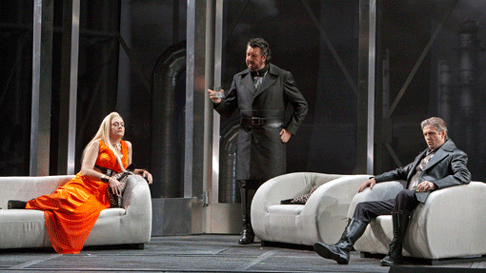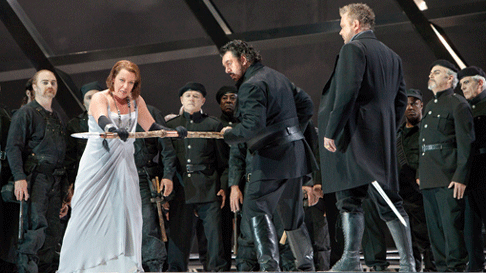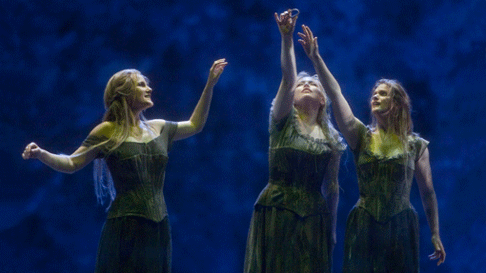06 Jul 2011
Der Ring des Nibelungen in San Francisco
Some of the experts said it was the best Ring ever, others merely said it was one of the best (these were lecturers at a Wagner Society symposium).

Some of the experts said it was the best Ring ever, others merely said it was one of the best (these were lecturers at a Wagner Society symposium).
The final curtain down at last on the second cycle, the audience leapt to its feet and roared. What was all the fuss about?
The delights of the San Francisco Ring were myriad. The cycle played out over a mere six days during which Wagner’s drama did not seem to stop. It was an immersion Ring rather than episodic one as the Freyer Ring in L.A. seemed over its ten long days, not to mention the Berlin Philharmonic Ring in Aix-en-Provence that was spread over four years.
Conductor Donald Runnicles slid into the initial E flat pedal tone and relentlessly sustained Wagner’s orchestral deliberation for its seventeen hour duration. The maestro drove an orchestral continuum that was imperceptibly fleet (it was actually fast), its speed though was calibrated to the careful articulation of Wagner’s score, the conductor knowing that Wotan’s plight and designs give rise to riveting music only when they are musically exploited to the maximum.
Mo. Runnicles achieved a rare transparency of orchestral sound in the War Memorial, the percolating inner voices of the continuum often shining brilliantly in the vast space of the hall as they can never do in the recordings we use to learn and casually listen to the Ring. And too the vast spaces of the War Memorial allowed huge fortes to roll forth, immersing the hall in mighty sound, Even the quirks of the hall contributed, its “golden horseshoe” overhang magnifying the eight horns and double timpani for those of us seated on the right side of the orchestra.
The careful musical exposition was subject to the largest arc of Wagner’s myth, the orchestral climax of the entire Ring occurring about sixteen hours into it, only at the end of the second act of Götterdämmerung when Mo. Runnicles unleashed it all for Brünnhilde’s pact with Hagen to murder Siegfried. This Ring was bigger than its pieces, and we understood that the usual frenzy we missed at the conception of Siegfried was measured against the hugely complex dilemma of his death.
It is futile to discuss the concept of the production, San Francisco Opera touting it as “an American Ring.” There were indeed vibrant American images, like redwood trees. like American industrial wastelands, but the Gibichung headquarters was well beyond the 1930’s American skyscrapers director Francesca Zambello cites in her program book apology, and much more on the scale of Austrian expressionist Fritz Lang’s immense Metropolis of his 1927 film. And too the light green behind Brünnhilde’s fire seemed more like a weird color choice that an evocation of escaping industrial gases.
 Melissa Citro (Gutrune), Andrea Silvestrelli (Hagen) and Gerd Grochowski (Gunter)
Melissa Citro (Gutrune), Andrea Silvestrelli (Hagen) and Gerd Grochowski (Gunter)
All these specific images however quietly dissolved into the careful storytelling that was the hallmark of the Zambello production. Not a musical motive was left without a corresponding movement on the stage, no musical interludes were left on an abstract imaginative level but accompanied by moving projections — clouds, water, trains, fire, more clouds, etc. It was a fully illustrated Ring (take it or leave it) that (if you took it, and that took a while) eased you, even gracefully, inside the Ring’s musical universe.
It was an easy, engaging Ring that deflated Wagnerian philosophical pomposity at every turn with surprising, sometimes funny twists — Alberich attached to his homeless supermarket cart searched for Faftner with infrared binoculars, the forlorn Rhine maidens hopelessly picked up plastic bottles from a dried up river bed, beer guzzling buddies who were actually sworn enemies downed cases. Not to mention the purely comic book, utterly delightful visuals for Fafner and Fasolt, or the Valkyries parachuting onto the rocks of Valhalla (this image said to have been borrowed from a Swedish commercial for a detergent powder).
Finally the Zambello Ring maybe even arrived at tongue-in-cheek with the black covered Arab-esque women cowering in the wake of their men, black uniformed fascistic soldiers of Hagen’s evil army. Not to intimate that Mme. Zambello did not somehow make all this bring Wagner alive. She did.
 Nina Stemme (Brünnhilde), Andrea Silvestrelli (Hagen), Ian Storey (Siegfried) and Ensemble
Nina Stemme (Brünnhilde), Andrea Silvestrelli (Hagen), Ian Storey (Siegfried) and Ensemble
San Francisco Opera promoted a number of seminars to accompany its Ring, Anti-Semitism was a big topic, though it was put in succinct perspective by the Mime of the production, David Cangelosi who rhetorically asked “haven’t we turned the page on all that?” Distinguished lecturers examined the Ring in Schopenhauerian terms, a former Buddhist monk delineated the Ring’s roots in Buddhism. The most convincing of the philosophical analogies described the Ring in purely Sartrean Existential terms. (I might also mention a concert of Wagner transcriptions on the 5000-pipe organ of St. Mary’s Cathedral — the Ride of the Valkyries executed by four hands and four feet and those 5000 pipes).
Well, none of that for the San Francisco Ring. While there were two real dogs portraying wolves, a bear played by a real man and a number of fantastic and dead animals involved, there was no horse at all for Brunnhilde to ride into the flames. The flames were fed by the downtrodden Gibichung women and the Rhine maidens throwing the plastic bottles picked up from the riverbed (tossed there by males in the context of this production). Gutrune, a male-victimized “moll” embraced Brünnhilde and we understood that she was redeemed. Photographs of the fallen heros rescued by the Valkyries showered down and at last a young girl planted a tree. Mo. Runnicles had had his fun with the murder pact, the usually spectacular ending instead was musically rather resigned.
This was not a minimal Ring created by veteran opera designer Michael Yeargan. There were four superimposed prosceniums and a sentient floor (lighted from underneath) that served as the stage mechanism for the Wagner mega-drama, with full stage screens flying in and out at all depths of the stage to capture the inexhaustible catalogue of projections developed by Jan Hartley and her associates. If the freeway interchange under which Wotan saw Siegmund die and where he murdered Hunding was not life size it seemed so. Hunding’s mountain cabin was as good as real as was Mime’s wrecked Airstream trailer.
What, you may ask, held all this together. It was the Brünnhilde of Swedish soprano Nina Stimme who brought bonafide Teutonic style to rock solid vocal production and muscular physicality to her indefatigably energetic Valkyrie. This Ring was Brünnhilde’s personal story, placed in even higher relief by the pallid portrayal of Wotan by American bass Mark Delavan, a performance that effaced the Wagnerian complexities and emotional stature of this human father cum transcendent being. The suspicion lurks that this was the intention of Zambello, a suspicion founded on the portrayal of Siegfried as one step above the village idiot, charmingly rendered by Jay Hunter Morris in Siegfried, and less vividly but vocally far more convincing by English tenor Ian Storey in Götterdämmerung.
 Lauren McNeese, Renée Tatum and Stacey Tappan (The Rhinemaidens).
Lauren McNeese, Renée Tatum and Stacey Tappan (The Rhinemaidens).
There were several performances that stood out among the universally good performances of the entire cast. The Siegmund of American tenor Brandon Jovanovich was disarmingly charismatic and Italian basso Andrea Silvestrelli created Zambello’s arch villain Hagen with supreme testosterone gusto. American tenor David Cangelosi as Zambello’s creepy hobo Mime succeeded in making the first two acts of Siegfried high points (well, among many) of the entire cycle.
San Francisco Opera does not seem to have been a competitor in who-can-spend-the-most-for-a-Ring contest. Still, there went a pile of gold. One assumes costumer Catherine Zuber was well rewarded for what was an heroic and immensely successful effort, as was the complex lighting of Mark McCullough — both seasoned opera pros, like Zambello and Yeargan and their supporting teams.
It was not a prestigious Ring, like the Aix Ring with the Berlin Philharmonic in the pit (by the way with the six harps Wagner requires — San Francisco made do with two) with its elegant, minimalist staging by Stéphane Braunschweig. It was not an arty Ring imagined in a rarefied visual language like the splendid L.A. Achim Freyer Ring, nor was it a big, international house Ring with proven big name interpreters and the flavor-of-the-day producer (by the way that would be the Robert Lepage Ring at the Met).
The San Francisco Ring was a good Ring, if a wacky one that seemed at times like it might even be a spoof. It was however, perhaps therefore absolutely understandable. The experts may debate how it betrayed or illuminated Wagner’s musico-philosophic treatise, but they too will admit that those seventeen hours in the War Memorial Opera House were full of fun and richly rewarding.
Michael Milenski